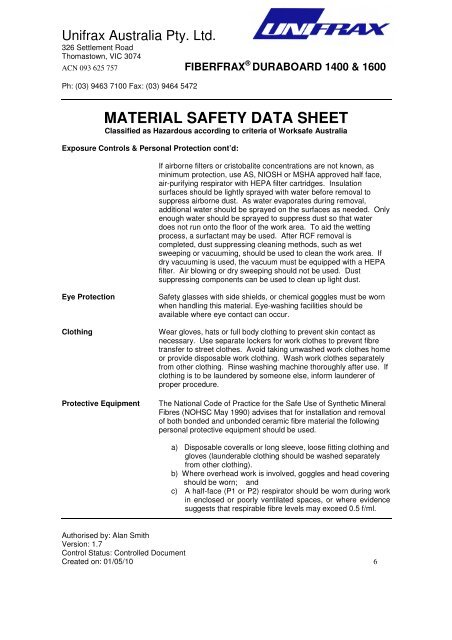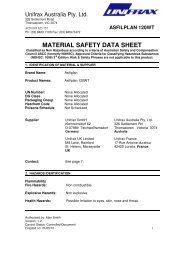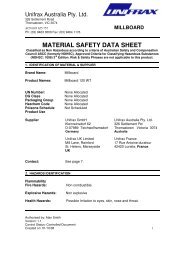MATERIAL SAFETY DATA SHEET - Unifrax Australia
MATERIAL SAFETY DATA SHEET - Unifrax Australia
MATERIAL SAFETY DATA SHEET - Unifrax Australia
Create successful ePaper yourself
Turn your PDF publications into a flip-book with our unique Google optimized e-Paper software.
<strong>Unifrax</strong> <strong>Australia</strong> Pty. Ltd.<br />
326 Settlement Road<br />
Thomastown, VIC 3074<br />
ACN 093 625 757 FIBERFRAX ® DURABOARD 1400 & 1600<br />
Ph: (03) 9463 7100 Fax: (03) 9464 5472<br />
<strong>MATERIAL</strong> <strong>SAFETY</strong> <strong>DATA</strong> <strong>SHEET</strong><br />
Classified as Hazardous according to criteria of Worksafe <strong>Australia</strong><br />
Exposure Controls & Personal Protection cont’d:<br />
If airborne filters or cristobalite concentrations are not known, as<br />
minimum protection, use AS, NIOSH or MSHA approved half face,<br />
air-purifying respirator with HEPA filter cartridges. Insulation<br />
surfaces should be lightly sprayed with water before removal to<br />
suppress airborne dust. As water evaporates during removal,<br />
additional water should be sprayed on the surfaces as needed. Only<br />
enough water should be sprayed to suppress dust so that water<br />
does not run onto the floor of the work area. To aid the wetting<br />
process, a surfactant may be used. After RCF removal is<br />
completed, dust suppressing cleaning methods, such as wet<br />
sweeping or vacuuming, should be used to clean the work area. If<br />
dry vacuuming is used, the vacuum must be equipped with a HEPA<br />
filter. Air blowing or dry sweeping should not be used. Dust<br />
suppressing components can be used to clean up light dust.<br />
Eye Protection Safety glasses with side shields, or chemical goggles must be worn<br />
when handling this material. Eye-washing facilities should be<br />
available where eye contact can occur.<br />
Clothing Wear gloves, hats or full body clothing to prevent skin contact as<br />
necessary. Use separate lockers for work clothes to prevent fibre<br />
transfer to street clothes. Avoid taking unwashed work clothes home<br />
or provide disposable work clothing. Wash work clothes separately<br />
from other clothing. Rinse washing machine thoroughly after use. If<br />
clothing is to be laundered by someone else, inform launderer of<br />
proper procedure.<br />
Protective Equipment The National Code of Practice for the Safe Use of Synthetic Mineral<br />
Fibres (NOHSC May 1990) advises that for installation and removal<br />
of both bonded and unbonded ceramic fibre material the following<br />
personal protective equipment should be used.<br />
a) Disposable coveralls or long sleeve, loose fitting clothing and<br />
gloves (launderable clothing should be washed separately<br />
from other clothing).<br />
b) Where overhead work is involved, goggles and head covering<br />
should be worn; and<br />
c) A half-face (P1 or P2) respirator should be worn during work<br />
in enclosed or poorly ventilated spaces, or where evidence<br />
suggests that respirable fibre levels may exceed 0.5 f/ml.<br />
Authorised by: Alan Smith<br />
Version: 1.7<br />
Control Status: Controlled Document<br />
Created on: 01/05/10 6






